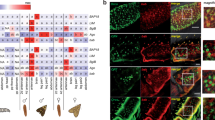Abstract
Female pink bollworm moths, Pectinophora gossypiella(Saunders), were selected for altered component ratios of the long-distance sex pheromone, (Z, E)-and (Z, Z)-7,11- hexadecadienyl acetate. Selection for 12 generations increased the mean (± SD) percentage of the (Z, E)isomer from 42.9 ± 1.0 in the parental generation to 48.2 ± 1.2. Although statistically significant, a change of this magnitude may be transparent to males because of their relatively broad response spectrum. Selection for a lower percentage of the (Z, E)isomer yielded no change in the mean pheromone ratio. The total amount of pheromone produced declined in both selected lines. In the line selected for females producing a high percentage of the (Z, E)isomer, the duration of wing fanning by males to high (Z, E)blends was elevated.
Similar content being viewed by others
References
Alexander, R. D. (1962). Evolutionary change in cricket acoustical communication.Evolution 16: 443–467.
Baker, T. C., Staten, R. T., and Flint, H. M. (1989). Use of pink bollworm pheromone in the southwestern United States. In Ridgway, R., Silverstein, R. M., and Inscoe, M. (eds.),Practical Application of Insect Pheromones and Other Attractants, Marcel Dekker, New York (in press).
Bierl, B. A., Beroza, M., Staten, R. T., Sonnet, P. E., and Adler, V. E. (1974). The pink bollworm sex attractant.J. Econ. Entomol. 67: 211–216.
Collins, R. D., and Cardé, R. T. (1985). Variation in and heritability of aspects of pheromone production in the pink bollworm moth,Pectinophora gossypiella (Lepidoptera: Gelechiidae).Ann. Entomol. Soc. Am. 78: 229–234.
Collins, R. D., and Cardé, R. T. (1989a). Heritable variation in pheromone response of the pink bollworm,Pectinophora gossypiella (Lepidoptera: Gelechiidae).J. Chem. Ecol. (in press).
Collins, R. D., and Cardé, R. T. (1989b). Selection for increased pheromone response in the male pink bollworm,Pectinophora gossypiella (Lepidoptera: Gelechiidae).Behav. Genet, (in press).
Collins, R. D., and Cardé, R. T. (1989c). Wing fanning as a measure of pheromone response in the male pink bollworm,Pectinophora gossypiella (Lepidoptera: Gelechiidae).J. Chem. Ecol. (in press).
Collins, R. D., Rosenblum, S. L., and Cardé, R. T. (1989). Selection for increased pheromone titre in the pink bollworm moth,Pectinophora gossypiella (Lepidoptera: Gelechiidae).Physiol. Entomol. (in press).
Doane, C. C., and Brooks, T. W. (1981). Research and development of pheromones for insect control with emphasis on the pink bollworm. In Mitchell, E. R. (ed.),Management of Insect Pests with Semiochemicals, Plenum Press, New York, pp. 285–303.
Du, J.-W., Linn, C. E., Jr., Roelofs, W. L. (1984). Artificial selection for new pheromone strains of red banded leafroller mothsArgyrotaenia velutinana.Contr. Shanghai Inst. Entomol. 4: 21–30.
Falconer, D. S. (1973). Replicated selection for body weight in mice.Genet. Res. 22: 291–321.
Falconer, D. S. (1981).Introduction to Quantitative Genetics, 2nd ed., Longman, London.
Graham, H. M., Glick, P. A., and Martin, D. F. (1964). Nocturnal activity of adults of six lepidopterous pests of cotton as indicated by light-trap collections.Ann. Entomol. Soc. Am. 57: 328–332.
Grant, G. G., French, D., and Grisdale, D. (1975). Tussock moths: Pheromone cross stimulation, calling behavior, and effect of hybridization.Ann. Entomol. Soc. Am. 68: 519–524.
Grula, J. W., and Taylor, O. R., Jr. (1979). The inheritance of pheromone production in the sulphur butterfliesColias eurytheme and C.philoice. Heridity 42: 359–371.
Haynes, K. F., Gaston, L. K., Mistrot Pope, M., and Baker, T. C. (1984). Potential for evolution of resistance to phermones: Interindividual and interpopulational variation in chemical communication system of pink bollworm moth.J. Chem. Ecol. 10: 1551–1565.
Hummel, H. E., Gaston, L. K., Shorey, H. H., Kaae, R. S., Byrne, K. J., and Silverstein, R. M. (1973). Clarification of the chemical status of the pink bollworm sex pheromone.Science 181: 873–875.
Klun, J. A., and Maini, S. (1979). Genetic basis of a chemical-communication system: European corn borer.Environ. Entomol. 8: 423–426.
Kyriacou, C. P., and Hall, J. C. (1986). Interspecific genetic control of courtship song production and reception inDrosophila.Science 232: 494–497.
Lanier, G. N., Classon, A., Stewart, T., Piston, J. J., and Silverstein, R. M. (1980).Ips. pini: The basis for interpopulation differences in pheromone biology.J. Chem. Ecol. 6: 677–687.
Linn, C. E., Jr., and Roelofs, W. L. (1985). Response specificity of male pink bollworm moths to different blends and dosages of sex pheromone.J. Chem. Ecol. 11: 1583–1590.
Linn, C. E., Campbell, M. G., and Roelofs, W. L. (1988). Temperature modulation of behavioural thresholds controlling male moth sex pheromone response specificity.Physiol. Entomol. 13: 59–67.
Roelofs, W. L., Du., J.-W., Linn, C., Glover, T. J., and Bjostad, L. B. (1986). The potential for genetic manipulation of the redbanded leafroller moth sex pheromone blend. In Huettle, M. D. (ed.),Evolutonary Genetics of Invertebrate Behavior, Progress and Prospects, Plenum Press, New York.
Roelofs, W., Glover, T., Tang, X.-H., Sreng, I., Robbins, P., Eckenrode, C., Lofstedt, C., Hansson, B., and Bengtsson, B. O. (1987). Sex pheromone production and perception in European corn borer moths is determined by both autosomal and sex-linked genes.Proc. Natl. Acad. Sci. USA 84: 7585–7589.
Roush, R. T., and Croft, B. A. (1986). Experimental population genetics and ecological studies of pesticide resistance in insects and mites. In Board of Agriculture, National Research Council (eds.),Pesticide Resistance: Strategies and Tactics for Management, National Academy Press, Washington, D.C.
Sanders, C. J., Daterman, G. E., and Ennis, T. J. (1977). Sex pheromone responses ofChoristoneura spp. and their hybrids (Lepidoptera: Tortricidae).Can. Entomol. 109: 1203–1220.
Sokal, R. S., and Rohlf, F. J. (1981).Biometry: The Principles and Practices of Statistics in Biological Research, 2nd ed., W. H. Freeman, New York.
Steel, R. G. D., and Torrie, J. H. (1980).Principles and Procedures of Statistics, McGraw-Hill, New York.
Van Steenwyk, R. A., Ballmer, G. R., and Reynolds, R. T. (1978). Nocturnal trap catches of the pink bollworm.Ann. Entomol. Soc. Am. 71: 354–356.
Author information
Authors and Affiliations
Rights and permissions
About this article
Cite this article
Collins, R.D., Cardé, R.T. Selection for altered pheromone-component ratios in the pink bollworm moth,Pectinophora gossypiella (Lepidoptera: Gelechiidae). J Insect Behav 2, 609–621 (1989). https://doi.org/10.1007/BF01065782
Accepted:
Issue Date:
DOI: https://doi.org/10.1007/BF01065782




